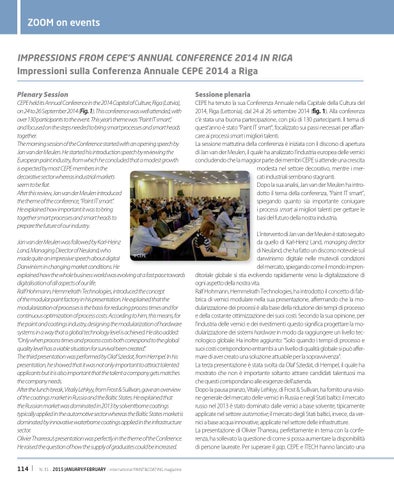ZOOM on events
IMPRESSIONS FROM CEPE’S ANNUAL CONFERENCE 2014 IN RIGA Impressioni sulla Conferenza Annuale CEPE 2014 a Riga Plenary Session
Sessione plenaria
CEPE held its Annual Conference in the 2014 Capital of Culture, Riga (Latvia), on 24 to 26 September 2014 (Fig. 1). This conference was well attended, with over 130 participants to the event. This year’s theme was “Paint IT smart”, and focused on the steps needed to bring smart processes and smart heads together. The morning session of the Conference started with an opening speech by Jan van der Meulen. He started his introduction speech by reviewing the European paint industry, from which he concluded that a modest growth is expected by most CEPE members in the decorative sector whereas industrial markets seem to be flat. After this review, Jan van der Meulen introduced the theme of the conference, “Paint IT smart”. He explained how important it was to bring together smart processes and smart heads to prepare the future of our industry.
CEPE ha tenuto la sua Conferenza Annuale nella Capitale della Cultura del 2014, Riga (Lettonia), dal 24 al 26 settembre 2014 (fig. 1). Alla conferenza c’è stata una buona partecipazione, con più di 130 partecipanti. Il tema di quest’anno è stato “Paint IT smart”, focalizzato sui passi necessari per affiancare ai processi smart i migliori talenti. La sessione mattutina della conferenza è iniziata con il discorso di apertura di Jan van der Meulen, il quale ha analizzato l’industria europea delle vernici concludendo che la maggior parte dei membri CEPE si attende una crescita modesta nel settore decorativo, mentre i mercati industriali sembrano stagnanti. Dopo la sua analisi, Jan van der Meulen ha introdotto il tema della conferenza, “Paint IT smart”, spiegando quanto sia importante coniugare i processi smart ai migliori talenti per gettare le basi del futuro della nostra industria.
Jan van der Meulen was followed by Karl-Heinz Land, Managing Director of Neuland, who © CEPE made quite an impressive speech about digital Darwinism in changing market conditions. He explained how the whole business world was evolving at a fast pace towards digitalisation of all aspects of our life. Ralf Hohmann, Hemmelrath Technologies, introduced the concept of the modular paint factory in his presentation. He explained that the modularization of processes is the basis for reducing process times and for continuous optimization of process costs. According to him, this means, for the paint and coatings industry, designing the modularization of hardware systems in a way that a global technology level is achieved. He also added: “Only when process times and process costs both correspond to the global quality level has a viable situation for survival been created”. The third presentation was performed by Olaf Sziedat, from Hempel. In his presentation, he showed that it was not only important to attract talented applicants but it is also important that the talent a company gets matches the company needs. After the lunch break, Vitaliy Lehkyy, from Frost & Sullivan, gave an overview of the coatings market in Russia and the Baltic States. He explained that the Russian market was dominated in 2013 by solventborne coatings typically applied in the automotive sector whereas the Baltic States market is dominated by innovative waterborne coatings applied in the infrastructure sector. Olivier Tharreau’s presentation was perfectly in the theme of the Conference. He raised the question of how the supply of graduates could be increased. 114
N. 31 - 2015 JANUARY/FEBRUARY - international PAINT&COATING magazine
L’intervento di Jan van der Meulen è stato seguito da quello di Karl-Heinz Land, managing director di Neuland, che ha fatto un discorso notevole sul darwinismo digitale nelle mutevoli condizioni del mercato, spiegando come il mondo imprenditoriale globale si stia evolvendo rapidamente verso la digitalizzazione di ogni aspetto della nostra vita. Ralf Hohmann, Hemmelrath Technologies, ha introdotto il concetto di fabbrica di vernici modulare nella sua presentazione, affermando che la modularizzazione dei processi è alla base della riduzione dei tempi di processo e della costante ottimizzazione dei suoi costi. Secondo la sua opinione, per l’industria delle vernici e dei rivestimenti questo significa progettare la modularizzazione dei sistemi hardware in modo da raggiungere un livello tecnologico globale. Ha inoltre aggiunto: “Solo quando i tempi di processo e suoi costi corrispondono entrambi a un livello di qualità globale si può affermare di aver creato una soluzione attuabile per la sopravvivenza”. La terza presentazione è stata svolta da Olaf Sziedat, di Hempel, il quale ha mostrato che non è importante soltanto attrarre candidati talentuosi ma che questi corrispondano alle esigenze dell’azienda. Dopo la pausa pranzo, Vitaliy Lehkyy, di Frost & Sullivan, ha fornito una visione generale del mercato delle vernici in Russia e negli Stati baltici: il mercato russo nel 2013 è stato dominato dalle vernici a base solvente, tipicamente applicate nel settore automotive; il mercato degli Stati baltici, invece, da vernici a base acqua innovative, applicate nel settore delle infrastrutture. La presentazione di Olivier Tharreau, perfettamente in tema con la conferenza, ha sollevato la questione di come si possa aumentare la disponibilità di persone laureate. Per superare il gap, CEPE e ITECH hanno lanciato una
